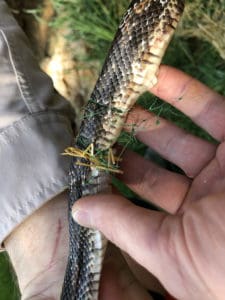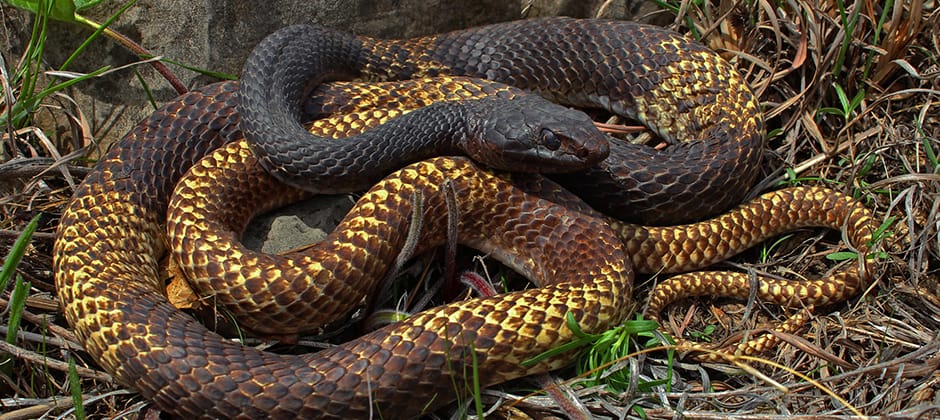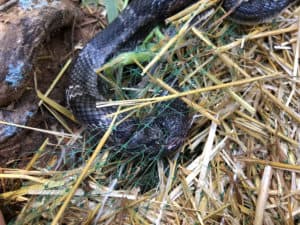Share this article
WSB: Erosion blankets can tie snakes into knots
As Christopher Schalk was conducting research on roadkill in Texas, he noticed the roadways were often lined for miles and miles with erosion control blankets — materials often required by government regulations to prevent soil loss and stimulate vegetation growth in areas cleared for construction.
Schalk, an assistant professor of forest wildlife management at Stephen F. Austin State University, began to wonder what effects these blankets might have on wildlife. After finding a number of reports of snakes getting tangled in them, he decided to take a deeper look. A literature review showed over 43% of snake entanglements were happening in erosion control products.
That sent Schalk into the field. He and his co-authors of a study published recently in the Wildlife Society Bulletin conducted field surveys at nine sites that used a type of erosion blanket made of polypropylene. After visiting these sites 65 times over 43 days, they found 10 snakes tangled up in the erosion blankets. Seven were found dead in a field. One died in a laboratory after researchers freed it. The other two survived.
“It’s a pretty brutal death,” Schalk said. The snakes often cut themselves on the netting as they twist around trying to get free, he said, and subjected to the hot Texas sun, the wounded snakes are sometimes attacked by fire ants.
For the next part of the research, the team set out to test whether there were differences between different types of erosion blankets. One was woven together with coconut fibers, a fairly flexible material. Another was made from polypropylene netting with three stiffer, thicker layers. A third was also made of two polypropylene layers, but with a mixture of coconut fiber and straw in between.
They put 128 snakes from 14 species collected around Texas in an enclosure with three types of netting during different trials. They allowed the snakes to explore the areas for three minutes, or until they got caught in the erosion blankets, at which point the researchers freed them.
“It can be challenging to try to work them out,” Schalk said.
These species were all non-venomous. “I don’t want to be trying to untangle a copperhead,” he said.
The researchers discovered that the blankets using coconut and straw — the type most similar to the ones they saw used at the construction sites — was most likely to tangle up snakes, which got stuck trying to slither between the different layers. At some point, the snakes would poke their heads through the mesh and try to force themselves through, while thicker parts of their bodies got stuck.
“They couldn’t back out because they forced themselves so deep in the mesh,” Schalk said.

When snakes like this Texas rat snake die from entanglement, they often die after cutting themselves while trying to get free. ©Cory Adams
The team found that thicker snakes were more likely to get caught. For every millimeter of extra thickness in body circumference, the snake’s likelihood of getting stuck increased 4%.
This is partly reflected in the types of snakes they found stuck in the netting in the wild. Four of the snakes were relatively thick North American racers (Coluber constrictor), three coachwhips (Coluber flagellum), two Texas rat snakes (Pantherophis obsoletus) and one plain-bellied water snake (Nerodia erythrogaster).
While current transportation regulations require that construction contractors mitigate soil loss, Schalk said, they should also consider wildlife entanglement when choosing erosion controls. In addition to snakes, the researchers also found a bronze frog (Lithobates clamitans) entangled in netting as well as a number of large beetles, while lizards have also gotten stuck, according to reports. “Potentially, you can see a wide variety of animals at risk of entanglement in these erosion control products,” he said.
Texas has 110 types of approved netting that construction contractors can choose from, Schalk said, but he and his co-authors only tested three. He urged more studies to determine what types are safest for wildlife.
“We’re just starting to scratch the surface,” he said.
This article features research that was published in a TWS peer-reviewed journal. Individual online access to all TWS journal articles is a benefit of membership. Join TWS now to read the latest in wildlife research.
Header Image: Coachwhip snakes were among those found discovered entangled in erosion blankets.









